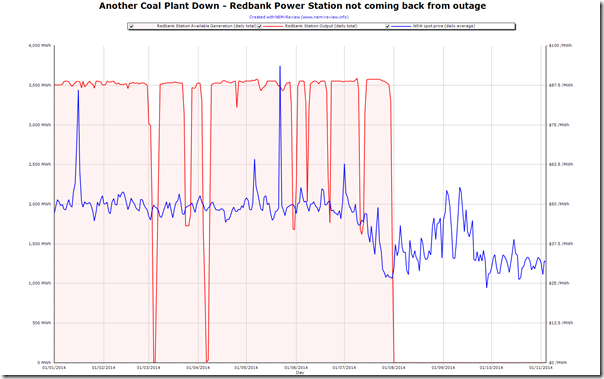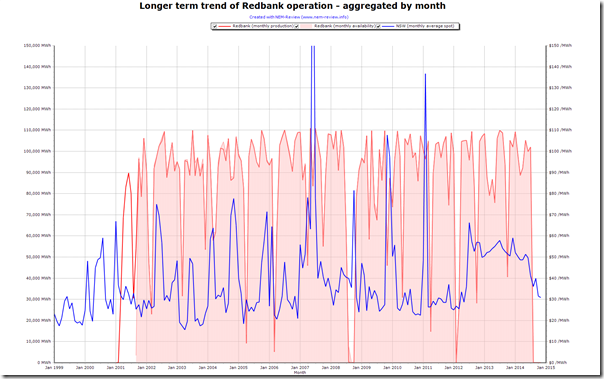News this week is that Redbank power station won’t be returning from the outage that began at the start of August.
Here’s a view (taken from NEM-Review ) of how the station operated through 2014, complete with the daily average NSW spot price highlighting how prices have dropped following the backing out of the carbon tax:
As shown above, Redbank tended to generate as much as it had available through any of the days through 2014 (compared with other stations in larger portfolios which have backed off output to rise prices and hence portfolio revenues) – but even this was not enough to stave off closure.
Here’s the same trend aggregated by month and shown over the entire range of NEM history – this illustrates how Redbank continually just generated as much as they were able (being a “price taker” in the NSW region):
Given the oversupply of capacity illustrated here (likely to increase with ongoing injections of capacity to continue with the current RET target), the closure of a more stations is expected into the future – it’s just more of a question of who next, when, and will it be orderly or disorderly (hence potentially impacting on security of supply)?




The Labour government tried to purchase some of the older coal-fired power stations such as Hazelwood in Vic and Playford in SA, but the asset owners appeared to be holding out for a higher price than the government was prepared to offer, expecting that power demand would continue to increase. I wonder how many coal-fired asset owners now regret them not having taken up the government’s offer. This would have provided a more orderly path to reducing coal-fired capacity than waiting for receivers to step in.
Re security of supply with volatile wind and solar renewable energy, existing hydro investments could be used for much more generation balancing to complement the volatility of wind than it currently is, particularly the Tasmanian hydro stations. The Snowy stations and Dartmouth are used in this way, but while the carbon tax was applied Tasmanian hydro did little more than provide baseload power across Bass Strait, selling into what was at the time a higher priced market. In the process it has run down the hydro dams to one third of capacity, and now imports brown-coal power from Victoria, which is now cheaper without the carbon tax.
The NEM covers two quite different markets with different economic drivers. There is the SA-Vic-Tas cluster, which has the majority of the NEM’s wind and hydro capacity, and all its brown coal capacity. There is also the NSW-Qld cluster, which is driven by black coal, gas, and a relatively small amount of wind and hydro (but that hydro has important capacity for security of supply – Tumut 3 has a 1500 MW capacity but only enough water for a 4% capacity factor). The linkage between these markets has a capacity of little more than 1000 MW, so when it is maxed out, there is no further capacity for generation balancing. To accommodate the intermitancy of wind in the SA and Vic markets, better use could be made of Basslink and existing Tasmanian hydro stations. Basslink has a capacity of ~500 MW, but this could go from -500 MW (Vic to Tas) to + 500 MW (Tas to Vic), thus providing a potential buffer of 1000 MW. Unfortunately now that Tasmania have run down their dams they may have little capacity to export into Vic at times of high power prices, so until their dams recover we are unlikely to see this desirable market behaviour. There are also peaking gas plants in Victoria and SA that can also cover the volatility, but as gas prices increase they will need a higher power price before dispatching power from their plants.
You should have a running tipping contest for which station is to be closed or mothballed next similar to your annual peak load contest – however you would probably have to give away too many BBQ’s to keep up over the next12 months. Or is everyone still pretending that “bid unavailable” and “peaking duty” are different to mothballing?